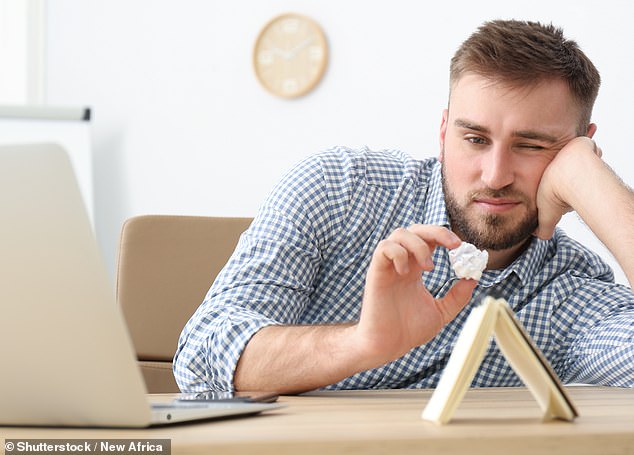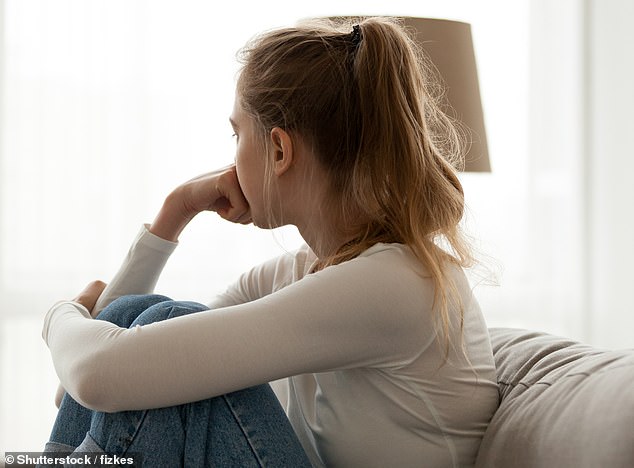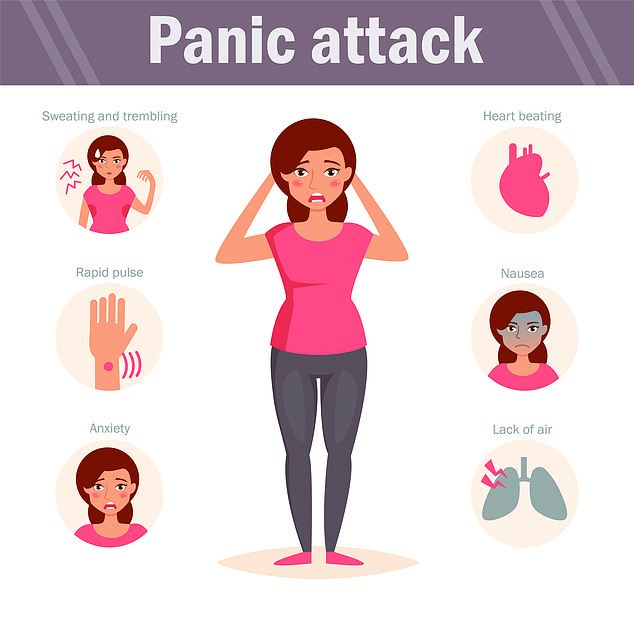Daily habits that increase the risk of panic attacks – as Elizabeth Olsen revealed that she had “every hour” in her 20s.
A panic attack can ruin your day, and even your week. And while you may be able to identify the cause – a job loss or a divorce – a long list of seemingly harmless habits can also trigger an attack.
From pouring a cup of coffee in the morning to following the news, everyday activities can cause a lot of anxiety.
Even getting out into the cold winter air can cause panic. Actress Elizabeth Olsen recently revealed that going from hot to cold temperatures made her nervous.
These anxiety attacks are sometimes confused with heart attacks because the symptoms often overlap. Both can cause hyperventilation and chest pain, shortness of breath, sweating and nausea.
About 1 in 10 Americans experience a panic attack each year, and about a third will have at least one at some point in their lives.
For many, panic attacks seem to happen out of the blue, but experts warn that some everyday habits that we see as normal and harmless can be the ones that make people overdo it.

Elizabeth Olsen, shown in September 2024, described her battle with anxiety, saying she had an attack almost every hour. Even going from hot to cold temperatures can cause it to shrink

About 1 in 10 Americans experience a panic attack each year, while a third will have one at least once in their lifetime.
Elizabeth Olsen opened up about her battle with panic attacks in her 20s, which struck every hour.
He said: ‘In fact, it was like any time there was a change in something: hot to cold, hungry to full. I thought, “Oh, is this okay?” And then it would come around, and become this habit.
‘I lived on 13th Street between 6th and 7th. I was crossing 6th Avenue at 14th Street, and I realized I couldn’t cross the street – I stood against the wall, and I thought I was going to drop dead at any moment.’
When a person is nervous, the symptoms appear suddenly, increase, and disappear gradually, although it may feel like forever.
There are usually triggers, such as stress or fear, but sometimes they happen for no apparent reason. At this point the body’s fight or flight response is enhanced.
Physical symptoms appear afterward, including chest tightness, rapid heart rate, hyperventilating, dizziness, and tremors.
Panic and racing thoughts intensify. A person may experience impending doom or a sense of impending doom. It often feels like you’re suffocating.
Side effects include confusion, fatigue, headaches, and feelings of emotional and physical exhaustion.
One panic attack is enough to convince someone that they never want to have another, and they may try to self-examine their own health to identify potential stressors. sink into another fear.
But if they are too focused on uncovering a suppressed trauma, they may not be looking for the little things they do every day.
One of the things that make people panic is the fear of having another panic attack.
Attiya Awadallah, a New York-licensed therapist who often treats Millennials and Gen Zers, told DailyMail.com: “One of the biggest triggers I see is fear itself. consumers are afraid simply because they are afraid to have it.
‘This anticipatory anxiety causes the body to react to the slightest unpleasant sensation, escalating into a full-blown attack before they realize what is happening.’
The fear of a panic attack – or any perceived threat – causes the body’s fight or flight response, which triggers the production of the hormones adrenaline and cortisol, as well as the neurotransmitters dopamine and serotonin.

Avoidance and procrastination are often a way for people with anxiety to avoid situations that trigger a panic attack. But experts say this policy always backfires, causing more panic in the end
Once the fight-or-flight response kicks in, the physical symptoms add to the anxiety, which makes those symptoms worse, taking the emotional wave away. The fear of an attack triggers a panic response, increasing the anxiety of anticipation into a full-blown panic attack.
Leaving your house in winter can also make you nervous, according to Ms Awadallah.
Rapid changes between cold and hot environments can raise heart rate and cause discomfort. For those with high anxiety, these physical sensations may be misinterpreted as the beginning of a panic attack, causing a self-inflicted cycle.
Thinking ‘why do today what you can put off until tomorrow’ is also known to cause fear. However, one in five Americans is a procrastinator.
Ms Awadallah said: Avoiding difficult or unpleasant activities can provide temporary relief, but allows anxiety to build up later.
‘Each time work is delayed, anxiety builds, until the mounting pressure explodes into fear, often unexpectedly.’
Many people develop avoidance or delay behavior to avoid situations in which they may be afraid, such as exiting the subway or avoiding crowded stores and places of ‘ music.
At the same time, they may over-indulge in their duties and responsibilities to combat the natural tendency to isolate themselves and avoid social gatherings. Keeping busy can often distract from anxiety, and being with friends can also ease symptoms.
But agreeing to too many social relationships or taking on too many responsibilities at work can have negative consequences, according to Dr. Danyell Taylor, licensed therapist in Chicago.
Dr Taylor told DailyMail.com: ‘I would add to this discussion about over-scheduling or over-commitment, as we often find ourselves filling our calendar with back-to-back activities, which can leave us with little time. of rest and recovery.
‘Unknowingly, this can cause anxiety and fear.’

The fear of having a panic attack can itself cause a panic attack. Experts say it creates a lot of emotions, where the fear of an attack triggers a real panic response, turning the expected anxiety into a full-blown panic attack.

A panic attack can last 10 to 20 minutes. It usually causes shortness of breath, palpitations, chest pain and sweating.
He also warned against skipping meals, a common practice popularized by health experts, celebrities, and biohackers who call it ‘intermittent fasting.’
Dr Taylor said: ‘While I think most of us are aware of the importance of good food and nutrition, neglecting good nutrition can lead to low blood sugar, which can cause symptoms. worry and fear.’
Without food, blood sugar drops, causing dizziness, irritability and mental fog. Not eating can also trigger the release of stress hormones, feeding feelings of anxiety.
Even our everyday conversations can cause fear. According to Ms. Awadallah, calling yourself anxious or stressed and assigning it to a part of your personality identifies anxiety as a core part of your identity.
By expecting to worry in every situation, you become stressed and oversensitive to stressors such as people or loud noises, which leads to even greater anxiety.
He said: ‘Encourage neutral or sympathetic views. Helping clients change their language (eg “I feel anxious” instead of “I’m worried”) can create distance between the person and the emotion, reducing their impact.’
Experts also advise you to put your phone down.
Ms Awadallah said: “Technology can overstimulate the mind, especially when combined with undermining or frequent exposure to negative news.
‘Constant exposure to information, especially dangerous or fear-inducing content, keeps the brain in a high state of anxiety.’
#Daily #habits #increase #risk #panic #attacks #Elizabeth #Olsen #revealed #hour #20s
